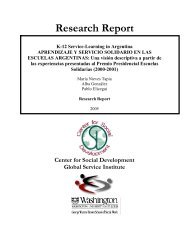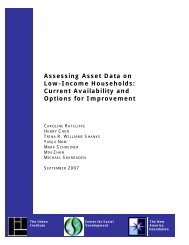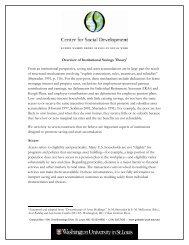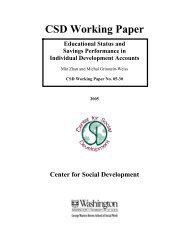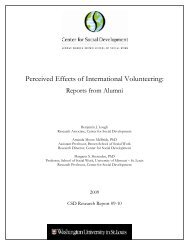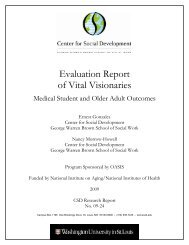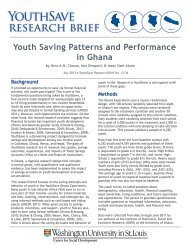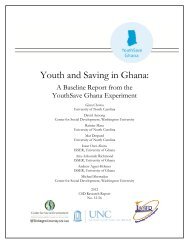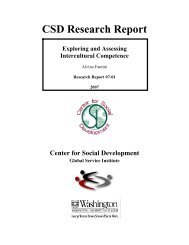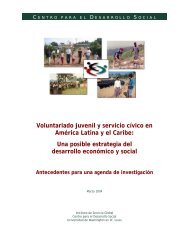Rediscovering social investment in developmental welfare state ...
Rediscovering social investment in developmental welfare state ...
Rediscovering social investment in developmental welfare state ...
Create successful ePaper yourself
Turn your PDF publications into a flip-book with our unique Google optimized e-Paper software.
R E D I S C O V E R I N G S O C I A L I N V E S T M E N T I N D E V E L O P M E N T A L W E L F A R E S T A T E P O L I C I E S :<br />
B A C K T O T H E F U T U R E<br />
more specific policy-relevant pr<strong>in</strong>ciples for th<strong>in</strong>k<strong>in</strong>g about <strong>developmental</strong> <strong>welfare</strong> and <strong>social</strong> policies<br />
together.<br />
Midgley (2003a) correctly asserts that Titmuss, Marshall, and other theorists us<strong>in</strong>g the<br />
representational approach separated the economic and <strong>social</strong> doma<strong>in</strong>s. However, Midgley‘s (1999, p.<br />
9) critique of the ―compartmentalization of <strong>social</strong> <strong>welfare</strong> and economic development‖ <strong>in</strong> <strong>welfare</strong><br />
statism has led to the assumption that <strong>welfare</strong> <strong>state</strong> conceptualizations of effort are <strong>in</strong>capable of<br />
account<strong>in</strong>g for the productive effects of <strong>social</strong> policy. This mistakes the theoretical neglect of<br />
productive <strong>social</strong> policy with the absence of productive <strong>social</strong> policy. Discard<strong>in</strong>g important aspects<br />
of the representational approach, it is mistakenly concluded that <strong>social</strong> expenditures <strong>in</strong> the form of<br />
consumption or ma<strong>in</strong>tenance are discrete from <strong><strong>in</strong>vestment</strong> expenditures. Despite this limitation, the<br />
central contribution of <strong>developmental</strong>ism to <strong>welfare</strong> <strong>state</strong> th<strong>in</strong>k<strong>in</strong>g is the addition of productive<br />
outcomes to the traditional preoccupation with protective outcomes.<br />
The <strong>welfare</strong> statist approach, while offer<strong>in</strong>g a lexicon for consider<strong>in</strong>g the types of policies that might<br />
constitute <strong>social</strong> <strong><strong>in</strong>vestment</strong>s, has not focused on productive outcomes. Consider Brigg‘s (1961)<br />
programmatic def<strong>in</strong>ition of the <strong>welfare</strong> <strong>state</strong>. He suggests that <strong>welfare</strong> <strong>state</strong>s have three goals: (1)<br />
economic security (i.e., protect<strong>in</strong>g citizens from common life risks by replac<strong>in</strong>g lost <strong>in</strong>come), (2)<br />
material sufficiency (i.e., provid<strong>in</strong>g a basic floor of <strong>social</strong> protection), and (3) basic services (ensur<strong>in</strong>g<br />
access to critical goods and services). These goals correspond to three policy categories: (1) <strong>social</strong><br />
security (i.e., <strong>in</strong>surance), (2) public assistance, and (3) services. In the traditional <strong>welfare</strong> <strong>state</strong> view<br />
focused on redistribution, it is not clear what is meant by the terms sufficiency or critical goods and<br />
services. What is the difference between m<strong>in</strong>imal and adequate, and to what does the term critical refer?<br />
A similar po<strong>in</strong>t can be made with respect to Esp<strong>in</strong>g-Andersen (2000d, pp. 161, 163), who<br />
dist<strong>in</strong>guishes ―m<strong>in</strong>imal needs‖ from a ―luxurious second-tier, universally <strong>in</strong>clusive, earn<strong>in</strong>gs-related<br />
<strong>in</strong>surance scheme on top of the flat-rate egalitarian one‖ geared to the ―discrim<strong>in</strong>at<strong>in</strong>g tastes of the<br />
new middle classes.‖ It is not clear why or how, <strong>in</strong> policy terms, pr<strong>in</strong>ciples such as universalism and<br />
decommodification extended to the new middle classes ―m<strong>in</strong>imize <strong>social</strong> problems and maximize<br />
revenue <strong>in</strong>come‖ (Esp<strong>in</strong>g-Andersen, 2000d, p. 163).<br />
Myrdal‘s version of <strong>welfare</strong> <strong>developmental</strong>ism emphasizes prevention and the <strong>in</strong>ternalization of<br />
externalized <strong>social</strong> costs <strong>in</strong> the economy (e.g., Pigou, 1929), where <strong>social</strong> organization or<br />
coord<strong>in</strong>ation is a prerequisite to economic efficiency (Stiglitz, 1996; Vartia<strong>in</strong>en, 2002). Social policy<br />
is a means of economic efficiency <strong>in</strong>sofar as <strong>in</strong>equality, <strong>in</strong>security, and <strong>social</strong> risk entail costs<br />
(Esp<strong>in</strong>g-Andersen, 1985) and underutilized resources. Welfare systems are seen as preconditions for<br />
economic development and growth, provid<strong>in</strong>g economic systems with the productive factors that<br />
they require (Tomassi, 2005). Growth depends on and translates <strong>in</strong>to human development, and<br />
human development depends on and translates <strong>in</strong>to growth, ad <strong>in</strong>f<strong>in</strong>itum (Ranis & Stewart, 2005).<br />
Implicit <strong>in</strong> this view is the idea that the <strong>in</strong>dividual citizen and household is not a self-conta<strong>in</strong>ed<br />
source of development but that <strong>in</strong>dividual ability is developed with assistance from outside. 32 The<br />
idea of human development relates to the notions of capability, endowments, opportunities, assets,<br />
and the like and implies that well-be<strong>in</strong>g is multidimensional. It also emphasizes build<strong>in</strong>g human<br />
capabilities, not simply <strong>in</strong>come or expenditures. As such, it holds potentially extensive implications<br />
for policies and programs, suggest<strong>in</strong>g that efforts to <strong>in</strong>crease capabilities as well as efforts to<br />
improve opportunities are important.<br />
32 Indeed, as Titmuss (1958, p. 44) observes, ―as man becomes more <strong>in</strong>dividual and more specialized he becomes more<br />
<strong>social</strong>ly dependent.‖<br />
C E N T E R F O R S O C I A L D E V E L O P M E N T<br />
W A S H I N G T O N U N I V E R S I T Y I N S T . L O U I S<br />
22



